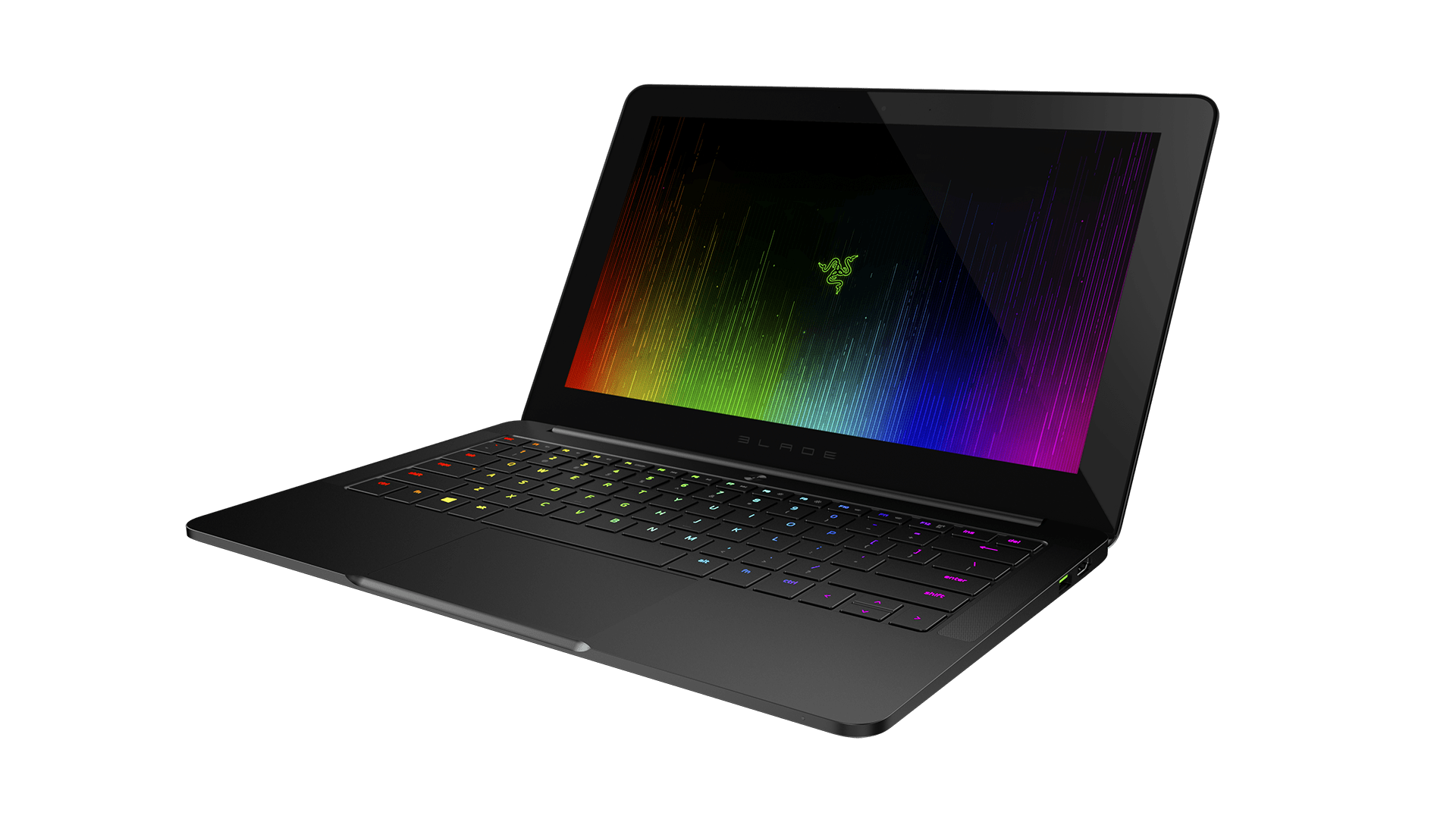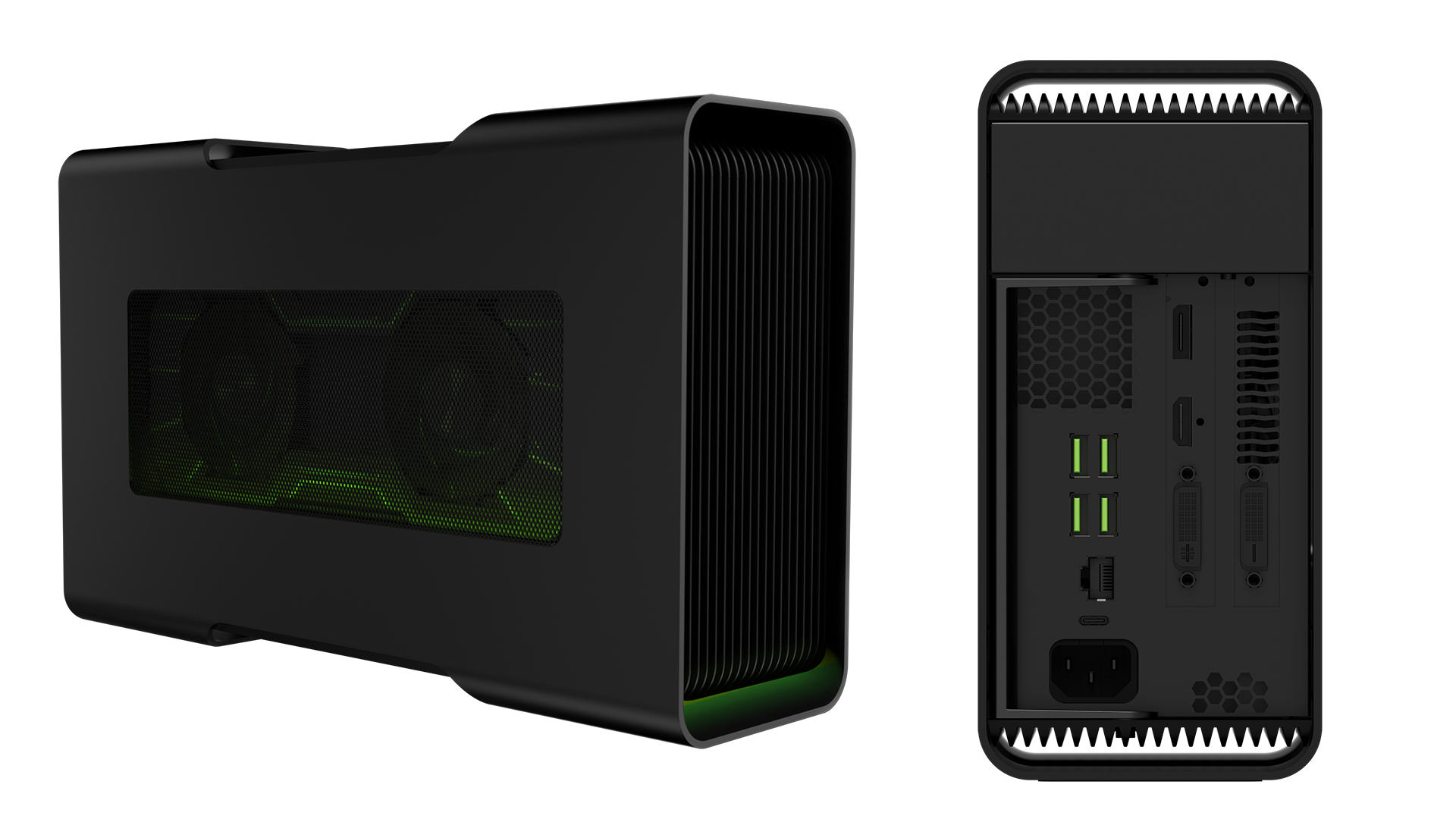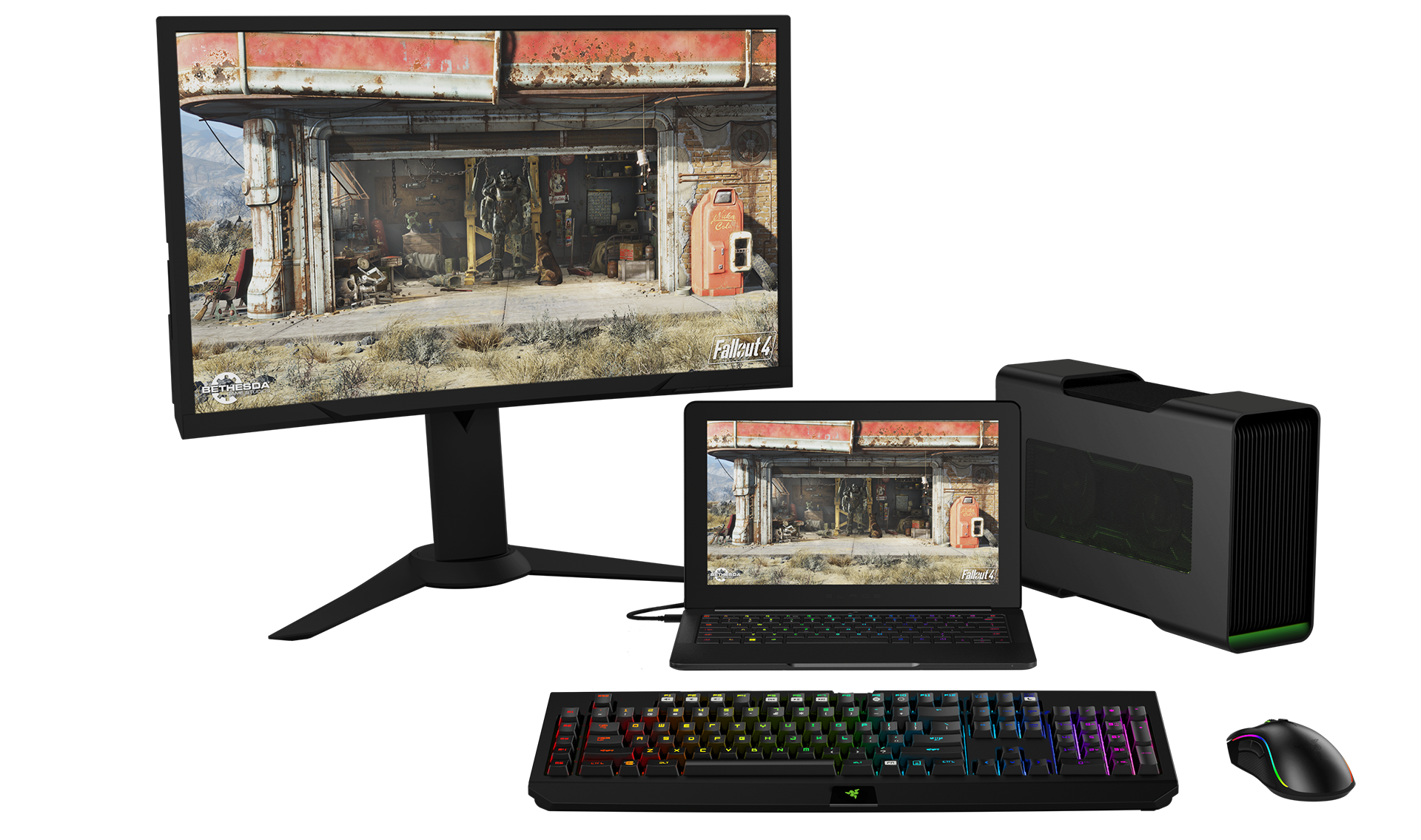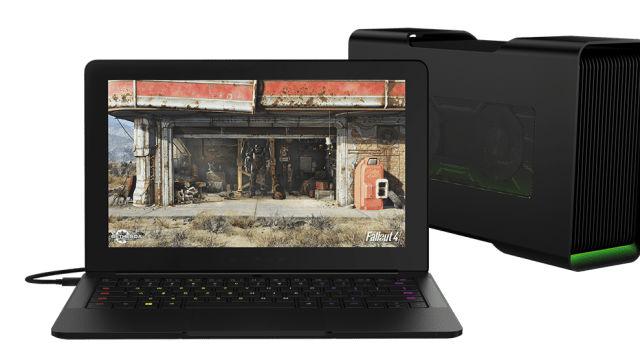Gaming peripheral and system maker Razer shows up at CES 2016 this week its smallest, cheapest Razer Blade laptop yet. The Razer Blade Stealth is Ultrabook sized, but with the optional Razer Core it can deliver desktop-level performance.
They’re calling the Razer Blade Stealth the “Ultimate Ultrabook”, and the specs fit the moniker. A mere 1.3cm thick and weighing only 1.24kg, Razer has packed the best bits that will safely run inside the smallest version of the distinctive aluminium Razer Blade housing yet.

Depending on the configuration, those bits include an Intel Core i7-6500U dual-core processor running at 2.5 or 3.1 GHz, SSD drives from 128 to 512 GB, 8 GB of dual-channel system memory and either a 2560 x 1440 QHD or 3840 x 2160 30cm UHD multi-touch indium gallium zinc oxide display.
And the keyboard lights up, thanks to the power of Razer Chroma technology. Each individual key can do its own thing. I’m a big fan of this.
The integrated Intel 520 graphics chip should be enough to handle most modern games at low settings or better, which is great for the Ultrabook form factor, but Razer is a gaming brand, so they have prepared a little something to help boost that performance. It’s a box!

This is the Razer Core, and it is a box built to house up to a double wide full-length graphics card of the desktop variety. It’s got four USB ports, a high-speed ethernet port, and two different light-up areas to ensure folks know this is a Razer product.
The Razer Core sits on your desk with a Thunderbolt cable hanging off of it. Plug that cable into the Razer Blade Stealth and it instantly begins to supply data, electricity and graphical power to the Ultrabook. Suddenly those product shots with the generic rainbow pattern become product shots featuring Fallout 4 wallpaper, because marketing.

Plug an external mouse, monitor and keyboard into the Razer Core and suddenly that Ultrabook is a 4K gaming system. A 4K gaming system with only 8GB of RAM, but still impressive.
What’s most impressive about the Razer Blade Stealth however, is the price. Since Razer is selling the system in their own online and offline shops when they launch in January (the Microsoft store begins selling them in February) they can keep the price relatively low compared to the competition — the Razer Blade Stealth starts at just $US999 ($1398), with the highest-end version ringing up at $US1599 ($2238). There’s still no price on the Razer Core, though since its just a box with connectors and cooling it shouldn’t be too expensive.
“Before today, gamers needed a portable system for everyday work and a separate desktop computer to power their PC games at the highest level possible,” says Min-Liang Tan, Razer co-founder and CEO via official announcement. “For the first time ever, there is no need for two separate systems. The Razer Blade Stealth offers the portability of an Ultrabook with the scalability to play hardcore games with desktop graphics performance thanks to the Razer Core.”
The Razer Blade Stealth is now on sale at the US Razer website, with shipping starting January 29. The Razer Core will ship in the first half of 2016. Unfortunately it is not yet in the Australian Razer store, but hopefully it is only a matter of time. I leave you with system specs.
Razer Blade Stealth:
- 12.5in. IGZO 16:9 aspect ratio, capacitive multi-touch display
- QHD(2560 x 1440)
- 128GB / 256GB PCIe SSD options
- UHD(3840 x 2160)
- 256GB / 512 GB PCIe SSD options
- Intel Core i7-6500U Dual-Core Processor (2.5 GHz / 3.1 GHz)
- Intel HD Graphics 520
- 128GB / 256 GB PCIe SSD options (QHD display models)
- 256GB / 512 GB PCIe SSD options (UHD display models)
- 8GB Dual-Channel System Memory (LPDDR3-1866MHz)
- Windows 10 (64-bit)
- Wireless-AC(802.11a/b/g/n/ac + Bluetooth 4.1)
- Thunderbolt 3 (USB-C)
- USB3.0 port x 2 (SuperSpeed)
- Built-inwebcam (2.0 MP)
- Chromaanti-ghosting keyboard with individually backlit keys
- HDMI1.4b audio and video output
- Built-instereo speakers
- 3.5mm headphone/microphone combo port
- Built-inarray microphone
- TrustedPlatform Module (TPM 2.0) security chip embedded
- Compact45 W USB-C power adaptor
- Built-in45 Wh rechargeable lithium-ion polymer battery
- 0.52in. / 13.1 mm (Height) x 12.6 in. / 321 mm (Width) x 8.1 in. / 206 mm (Depth)
- 2.75lbs. / 1.25 kg
Razer Core:
- Connectionto PC via Thunderbolt 3 using included 40Gbps cable
- Supportssingle double-wide, full-length, PCI-Express x16 graphics card
- GPUmax dimensions — 5.98 in. / 152 mm (Height) x 1.73 in. / 44 mm (Width) x 12.20in. / 310 mm (Length)
- GPUmax power support — 375 W
- USB3.0 port x 4 (SuperSpeed)
- GigabyteEthernet (10/100/1000)
- Chromalighting (2 zones)
- Built-in500 W power supply
- 8.6in. / 218.4 mm (Height) x 4.13 in. / 104.9 mm (Width) x 13.38 in. / 339.9 mm (Length)

Comments
29 responses to “The Smallest, Cheapest Razer Blade Laptop Yet Has A Powerful Friend”
This is something I can get behind. I’ve got an 11 inch Alienware laptop from 2011 which I absolutely love due to the small size, but there’s not really anything in that small size / not so small power range any more so it’s getting quite dated. Can absolutely see myself replacing it with this. Best of both worlds!
Alienware have a similar box for their newer laptops http://www.dell.com/content/products/productdetails.aspx/alienware-graphics-amplifier
They do, yes, but what they don’t have any more is an 11″ laptop. I think Origin were the last ones to do a gaming laptop in that size with the EON11-S. 12.5 still isn’t 11, but it’s closer than anything else (though only a little smaller than the Alienware 13″) at the moment.
A few companies are doing similar things now. It would be good if there was a standard so you can buy whichever laptop you want and then just connect the generic GPU box to any of them.
Yeah the idea of something like this MAY be enough to eventually convince me to give up my desktop. Maybe. If you could use that box to add more RAM in addition to the GPU it would be very difficult to pass up.
“Razer Blade Stealth starts at just $US999”
So about $2500 AUD based on the way Razer mark up their other laptops in Australia?
Sorry if it’s in there and I skipped over it, but can the Core be used with non Razer laptops?
In theory yes, it is likely just feeding PCI lanes from the thunderbolt controller straight to the video card. The other bub functionality probably is using the remaining USB lanes. And there have been other similar products before that could work with any Thunderbolt port, just not as well. Wait till someone else tries it but yeah I don’t see why not.
i read somewhere that theres something in the bios that allows it so i dont think all laptops will let it
I doubt it, Macbook Pro owner’s (and other laptops) have been using OWC (aka MacSales) Thunderbolt to PCI adapters for a few years now, they work natively on (AFAIK) all Thunderbolt computers. What would require some BIOS tweaks though is likely hotplugging the eGPU whilst the machine is running, something that I see being the next big hurdle to consumer grade eGPU enclosures.
I’m a little confused, I thought Mike Fahey was a US author yet this has clearly had some edits for us Aussies? Appreciated regardless.
There’s some automated edits for US articles to add AU conversions where possible, and that’s what the AU editing team is here for as well. Not just to write amazing, in-depth, quality articles, but to make sure the US ones meet our high Australian standards. 😛
Concept is actually cool, I fear buying all the parts from Razer would stack upto a pretty penny though. That screen size is also too small… 13inch is minimum and 15-17 is optimum. If it’s an ultrabook then they’re not that weighty or bulky.
Love the idea of having the desktop attachment at home for “serious” use.
Screen size on a small form factor laptop is a different beast. You’re trying to get portability for when you’re out and about and then most likely hooking up to an external monitor when it’s time for actual gaming. Different market to the 15/17 options.
Yeah true, smaller screen for sub-par gaming on the go and then 30inch bad boy (or full sized TV) waiting for you at home with the desktop attachment is still a pretty sweet setup.
So it’s only a gaming laptop when you’re at home? Why not just use something like Steam Link, a desktop, and a cheap laptop? Sounds like you’d get the same results, it would be more mobile than the Razer one (since you don’t have to plug it into the box to play the games), and would be easier to upgrade.
I guess it’s the portability of the laptop combined with the optional power of a desktop. You can still use Steam Link on your big screen but sometimes you just wanna use the laptop in other places like the toilet and bedroom?
I would be interested in this since I have a beast PC and been finding the best solution to play my games portably in my bedroom.
So I forgot that In-Home streaming is different from Steam Link.
I haven’t tried it before, but I’m 99% sure that can stream Steam directly from your Desktop to any laptop / windows tablet. The game runs on your desktop, so uses the desktop’s hardware instead of the portable device, your keyboard/mouse commands are streamed to the desktop which just streams the output back.
Yeah which makes me very tempted to get one of the new razer. Light and portable for everyday use and I can just roll on bed streaming from my PC.
Will have to see what kind of price they end up in AU first. Hopefully not some retarded price.
… but wouldn’t that steer you away from the Razer? I mean, since you’re utilizing your desktop’s hardware, you’re basically using the laptop as a portable access point for your desktop rather than a standalone gaming machine… so having that CPU and onboard storage on the Razer goes to waste when you’re at home… you’re just as well-off buying a $500 laptop.
I’ve gone through a lot of gaming laptops over the past few years.
While this isn’t a bad idea, I’m not entirely convinced. The Core i7-6500U dual-core is pretty weak, and will seriously bottleneck most desktop GPU’s. My work laptop (Asus UX303LB) is paired with the GTX 940m, which I think is the sweet spot for this CPU.
You’d be much better off with an i5-6300hq and up for this kind of get-up. Kinda like seen on the MSi GS30 Shadow.
I mean, the Razer is great and all. And build quality will totally kill the MSi – but it will end up being quite a lot of money to spend on something which will be incredibly bottlenecked on CPU intensive games.
This will be less and less of a problem with DX12 adoption tho, combined with the dual GPU setup of iGPU and eGPU.
So this year the to buy list will include the razer stealth and core plus the oculus rift.
Having said what I did above – I wouldn’t be surprised if I end up getting one.
They make such sexy machines. I would have bought their 970m model if it didn’t run so damn loud and hot.
So it’s BYO GPU for the Core thing? I wonder how much it will be. Author says it should be cheap but I have doubts. By the time you’re paying for the laptop, the Core, plus a GPU… might as well just a desktop, a cheap laptop and stream from Steam for half the price.
Yeah that’s what I was thinking. Buying a gpu that’s powerful enough to justify having a whole box for it to sit in by itself and therefore justify this whole setup would be anywhere from $500-1000. Even with the cost of the actual box notwithstanding, $2400-3300 to play fallout 4 is a bit much when you could buy a top of the line gaming pc and a top of the line laptop for that.
“The integrated Intel 520 graphics chip should be enough to handle most modern games at low settings or better…”
Not with a dual-core laptop CPU and an integrated GPU it won’t.
“There’s still no price on the Razer Core, though since its just a box with connectors and cooling it shouldn’t be too expensive.”
Not if you want to put in a powerful enough GPU to make the whole thing worthwhile. If you put in a cheaper GPU, you might as well just buy a higher-end gaming laptop to begin with, containing a 980M or something.
I’m just not sure I see the target market.
If it’s because you want (a) a laptop and (b) the ability to play games decently when at a desk, just buy a regular old laptop and use the saved money to buy a properly good gaming desktop.
If it’s because you want to play games while on the move, just save the money from purchasing the box and the external GPU to buy a better, “proper” gaming laptop with a 980M etc.
I guess the advantage of a separate box for your GPU like this is that you can upgrade the GPU in it at any time, which you can’t do with a normal laptop. It also shifts a lot of the heat producing components away from the laptop itself.
True, but in that case I’d honestly rather have an ‘okay’ laptop for, well, laptop-y stuff and a proper SFF/mATX desktop complete with the same ability to upgrade the GPU. But perhaps I’m just not the target market.